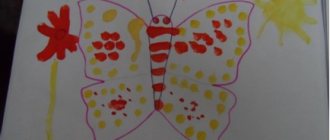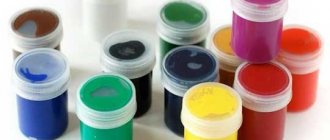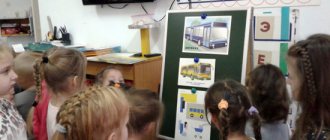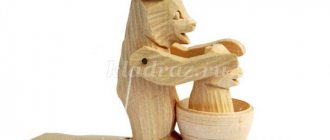Preview:
Drawing lesson for the middle group.
Theme "Beautiful napkins"
Goal: To teach children to decorate round napkins with patterns.
Children's goal: help Katya doll decorate the table for tea drinking.
Introduce children to the concept of “pattern”.
Show options for combining decorative elements by color and shape (dots, circles, spots, lines)
Develop a sense of color and rhythm in children.
Cultivate interest in folk arts and crafts.
1.Introduction to the game situation:
- Guys, we have guests today. These are parents, educators. Look at them, smile, wave.
- Now look at me. Eyes and ears are tuned, I’ll ask you about something interesting. Tell me please, do you like to visit?
- Today is Katya's doll's birthday, and she invites everyone to a tea party. What is tea drinking? Well done. Do you want to go visit her?
Approach the table on which there is a pre-made service set. Dolls are sitting on the sofas. Children stand around the corner.
Vosp.: Hello, Katya!
Katya: Hello children!
Vosp.: How elegant you are today, and what a wonderful table you have! Look kids, do you recognize it? Our set, which we sculpted as a gift for Katya.
Katya: Thank you guys, the service is wonderful. Very suitable for the holiday table.
Vosp.: Katya, where are the napkins on your table? Guys, isn’t it customary for us to set the table with beautiful napkins and towels? Do all mothers and grandmothers do this? To make it beautiful and festive?
Katya: Oh-oh, guys. I completely forgot about the napkins. I took them to wash and forgot about them. What to do?
Play: Children, you need to help Katya make beautiful, festive, painted napkins. Want to?
Katya: Oh, guys, can you?
Vosp.: Then you, Katya, sit with the guests for now, and the guys and I will give you another gift.
2. Visual activity.
- Guys, come to the tables and take your seats.
- I would like to invite you to paint your napkins with beautiful patterns.
- Guys, do you know what a pattern is?
- A pattern is the decoration of something with lines, dots, or circles. And this decoration creates a whole picture on napkins and towels. Which makes it very pleasant to look at them and makes the food taste better at the table. Want to see what patterns there are?
(remove the screen from the easel with samples)
- Guys, look, I think we can handle this pattern. Shall we try? (remove other patterns)
“Then prepare your ears so you don’t listen to anything, and your eyes so you don’t miss anything.” (Remove the sample, attach a blank circle)
- Let's take some brushes. Does everyone remember that we hold the brush with three fingers near the “piece of iron”?
- Now let's take yellow paint and draw a circle in the middle of our napkin, the size of a small tangerine. The circle should be filled inside. (Draw on the sample)
- Whoever drew the circle, rinse the brush thoroughly and wipe it with a cloth so that it is dry.
- Now we take green paint and paint around our yellow circle to make these green patterns. (Show on sample)
Go and see how it turns out. Individually help/give advice to those who cannot cope.
- Now put the brushes on rags. They won't be needed anymore. (Collect brushes and water)
- Now look what I have. What is this? (cotton swab)
- Do you think you can draw with a cotton swab?
- There is even a way to draw like this. Dots. Let's try. To do this, you need to take a little red paint with a stick and put dots along the edge of our napkin. Look how beautiful it turned out.
- Now you try it. (Hand out sticks)
- And now, to complete our beautiful pattern, you can put one dot in the middle of the yellow circle.
- Whoever has done everything, put the chopsticks on a cloth. Take your beautiful napkin and bring it here to the exhibition. (Oval table). Then take a damp napkin, wipe the handles and you can admire our patterns.
(quickly help the other children, take the Katya doll and bring it to the table, call all the children)
Vosp: Katya, look at what beautiful napkins we painted for you!
Katya: Children, what great fellows you are! You did so great! Now tea drinking will become even more beautiful and tastier! Thank you guys!
Vosp: Katya, go to the guests for now! Guys, I want to invite you to the carpet.
- Tell me, who did we help today?
- How could we help Katya?
- Why do you think we succeeded? (because we know how to draw patterns)
- Well done! You've done it. You can go play.
Preparing for the lesson “Decorating an apron”
Decorative drawing classes for children aged 4–5 years are aimed at solving two main problems:
- develop brush skills,
- develop the ability to put together a pattern from simple elements.
Decorative drawing in the middle group is painting a blank with a brush and paints
Paints and base for painting
- Gouache is the best option for painting an apron. The paint picks up well on the brush (without water), goes on smoothly, and the patterns come out bright and clear. Gouache can be painted on a white or colored background, the decoration will not merge with the base.
- Watercolor is acceptable. But only for drawing on a dense white base. The teacher carefully monitors how the children collect water and paint to remove excess moisture, otherwise they will drip onto the drawing or the patterns will spread.
Gouache is easy to apply to a brush, it is an ideal paint for five-year-olds
- The basis for drawing an apron is usually 1/2 A4 sheet: made of thick white paper, the teacher can pre-tint it with watercolors,
- from colored cardboard.
The teacher can cut out an apron blank for class
Sometimes children are asked to decorate apron blanks with colored pencils. It is not right. Colored pencils are used in the middle group for object drawing. In decorative drawing, kids can use a simple pencil to draw a stencil: they trace the apron on paper.
Techniques and drawing techniques
- Preliminary repetition and training of each technique: children “draw” circles and lines in the air with a dry brush,
- chalk on a blackboard (marker on a special board).
- leaves in a floral design: apply the brush with all its bristles to the paper and remove,
Important. The teacher monitors the completion of the practical task by the children. For those who have difficulty drawing, he shows techniques individually.
Children improve their gouache painting techniques under the supervision of a teacher
This is interesting. Painting an apron can be done with five-year-olds using an unusual technique. The guys will decorate the blanks using non-traditional materials and tools:
- wax crayons,
- cotton swabs or disks,
- pieces of sponge,
- fingers,
- stamps from vegetables or fruits.
It’s easy to make an unusual pattern on an apron by drawing with your fingers on wet paper
Combination with applique and modeling
When creating an “Apron” craft, drawing, applique, and sculpting techniques can be used. An apron painted with a pattern is perfectly complemented by various elements:
- pieces, strips of colored or wrapping paper,
- plasticine mosaic,
- strokes of plasticine,
- dried flowers, leaves,
- buttons, sequins.
The apron pattern can be complemented with a composition of autumn leaves, for example
Kids love decorating with stickers, glitter and other accessories. If access to these materials is opened at the beginning of practical work, the kids will make the craft in the form of an applique from all kinds of pieces and pictures. First, the children draw a pattern, and then the teacher brings a “magic box” with new decorations.
Individualization of tasks
Productive work and a good mood within the group are promoted by simple tasks aimed at satisfying the personal tastes and interests of the children:
- Take apart the apron blanks: round, triangular, with a frill - whoever wants which one.
- To decorate the apron, use colors and shades as desired.
- You can decorate the drawing with additional materials: applique, stickers.
For five-year-olds who show increased interest in drawing, the teacher complicates the overall task. For example, he asks to draw a flower arrangement in the center of the apron when the group draws one flower.
Children's work is not standard, each apron is unique and beautiful
Place of the lesson “Decorating an apron” in the drawing file
Decorative drawing in the middle group is conventionally divided into decorating blanks in the form of household items/clothing (sweater, mittens, dress, napkin) and painting in the style of folk crafts (Khokhloma, Gzhel, Dymkovo toy). The theme “Apron Decoration” is universal. Children can decorate an apron with a geometric/floral pattern or a folk ornament - this is determined by the teacher. A lesson is held in the middle of the school year, when the children study the topic “Clothing” and begin to get acquainted with folk art.
Theme options:
- "Mom's apron"
- "Magpie Apron"
- "Apron for Dymkovo toy"
- "A gift to my beloved grandmother."
While painting an apron for the Dymkovo young lady, the guys get acquainted with folk geometric patterns
Decorative drawing classes allow you to show children in a playful way that you can make plain things beautiful with your own hands or create a gift for a friend or relative. The introductory stage of the lesson is aimed at creating motivation in children to study patterns and create independent creativity.
Table: options for a motivating start to the lesson “Decorating an Apron”
| Motivational form | Content |
| Game situation | The teacher takes the children to the play corner and offers to show the scene “Katya the doll is waiting for guests.” The plot plays out the following points:
When the children bring the doll to the kitchen stove, the teacher draws attention: “Katyusha put on a beautiful, clean dress, but while cooking it can be splashed and dirty. What should I do? When the option was given that you need to put on an apron, the teacher hands the doll a white blank, she doesn’t like it. The guys will have to decorate an apron for Katya. |
| Poem reading and conversation | Children listen to the poem “An Apron for Mom.”
Questions for talking with kids:
|
| Studying visual material | This form is best for motivating folk patterns. Children look at an exhibition of objects made in the style to which the lesson is dedicated (Gzhel, Khokhloma or Dymkovo painting). For the lesson “Apron for a Dymkovo toy,” an exhibition of young ladies with different patterns on their aprons is selected: stripes, circles, leaves. Questions about the exhibition:
|
For five-year-olds, it is enough to consider several figures with different options for painted aprons
On the topic: methodological developments, presentations and notes
There on unknown paths Goal: .
To expand children's knowledge and understanding of the features of the appearance of a goldfish. Introduce an excerpt from “The Tale of the Goldfish” by A. S. Pushkin.
Teach children to respond to the poetry of A. S. Pushkin’s poetic lines.
Target. Learn to convey your impression of the autumn beauty of nature. Develop artistic and creative abilities.
Target. Continue to form an emotional response to the work of art.
Goal: Learn to draw horizontal lines, consolidate the ability to hold a brush correctly, consolidate colors: blue and red, cultivate aesthetic feelings. Vocabulary work: Horizontal lines, long.
summary of a drawing lesson in the middle group.
Source
Notes on drawing in the middle group “Teddy Bear”
Goal : to make children want to draw a bear using a stencil (outline), learn to paint along the contour using the “poke” method, consolidate knowledge of color (brown), and instill interest in drawing in different ways.
Materials: a sample of a finished drawing of a bear, an outline of a bear on a landscape sheet, a toy - a large brown bear, stencils, bristle brushes No. 4, thin soft brushes, a simple pencil, gouache (brown, black), napkins.
Progress of the lesson:
1. Organizational moment, problematic situation.
- Guys, it seems like someone is crying, can you hear it in the doll corner?
-Who is crying here? (Bear). Yes, this is Mishka the clubfooted one.
- How did you end up here, Mishka, and why are you crying? (The teacher voices the toy.)
- I came to you from the forest. Winter will come soon and I need to go to bed in the den.
“And why did this upset you so much?” After all, all bears sleep in their dens in winter. They feel warm and cozy there in winter.
- Yes it is. I already wanted to lie down in my den for the whole winter, but I remembered that I have no friends, I am so alone. And I felt very, very sad (crying).
- Don't cry, Mishka! You are so beautiful, fluffy, shaggy, calm down (Bear is crying).
- Oh, guys, what should we do? How can we cheer up Mishka? We need to help him find friends. But how? (Children's answers.)
- Can you draw it?
- Calm down, Mishka, don’t be sad, we will help you find friends as beautiful as you.
- Let's go to the tables (everything you need is there).
I have a friend in my hands for our Teddy Bear (show a sample and turn to the toy).
- Look, Mishka, you will have many such beautiful and kind friends.
2. Main part.
— Today we will draw a bear using a stencil. You have stencils of bears on your tables, they are all different: some have a bear standing, some have a bear dancing, some have a bear doing exercises. We will draw different friends for Mishka. To do this, you need to put the stencil on a sheet of paper and trace along the outline with a pencil.
- First, take the stencil in your hand and trace it with your finger. Like this. And then we will color the Bear, and we will do it in a new way. To depict the bear as fluffy, we will use a bristle brush. The brush will work in a special way: it will jump up and down. Take the brushes in your hands and try them without paint (show how the brush will work).
- Well done, you are doing everything right! We start coloring from the head. Look, I'm picking up paint. What color paint do we need to paint the bear? (Brown.)
— I pick up some brown paint and start drawing along the contour. I will go around the entire outline using the “poke” method, then I will paint over the entire bear using the same method. My brush is jumping up and down. The result was a beautiful, fluffy bear. But what did I forget to draw? (Eyes, mouth, nose.) To draw the eyes, mouth, nose, I will take a thin brush, dip it in black paint and paint with the end of the brush. What is my bear's mood?
3. Physical education minute: “Two bears were sitting…”
4. Independent activity of children.
- And now you will each draw your own bear. What kind of bears will you have - happy or sad?
5. Summing up.
Analysis: (I take a toy) Bear, look how many friends you have now! The kids tried so hard to help you. Now you can sleep peacefully in your den.
- Thank you, guys, I like this funny little bear, and this funny one, and I really like them all and now I have a lot of friends! Hooray! Goodbye!
- But before you leave, play with us (the game “Bear-toed Bear”).
- Thank you for staying with us to play. And now it's time for you to go into the forest, goodbye.
On the topic: methodological developments, presentations and notes
Topic: Let's decorate aprons for March 8th with a Tatar pattern Educational areas: artistic creativity, socialization, communication, music Type: harmonious development of children by means of art.
An open integrated lesson for artistic, aesthetic and cognitive development.
WILD ANIMALS. BEAUTIFUL NAPKIN Purpose: to develop the ability to recognize, name and distinguish the features of the appearance and lifestyle of wild animals; cultivate activity, independence, love.
"Beautiful napkins for Katya's doll."
Educational objectives: learn to create an image - a symbol of the Chuvash pattern depicting the sun, arranging the elements of the pattern and gluing them to the base. Developmental objectives: develop children's ability to place.
Summary of GCD in the junior group on artistic and aesthetic activities. “Let's decorate a napkin with a pattern.” Educator of the 1st category Novikova S.P. Tasks.-To consolidate with children the ability to draw mountains.
Source









